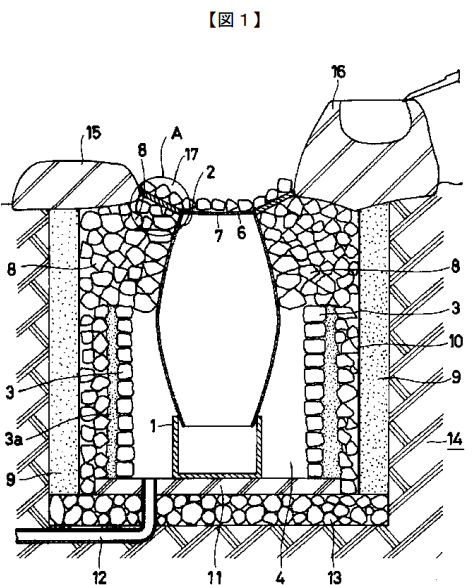
- Overview of the Patent Drawing
- Patent Insight 1: Acoustic Design for Sound Resonance
- Patent Insight 2: Water Management System for Optimal Functionality
- Patent Insight 3: Integration with Traditional Japanese Garden Aesthetics
- Patent Attorney’s Thoughts
- Keywords
- Application of the Technology: “Sound-Infused Zen Puzzle Room”
Overview of the Patent Drawing
The illustration shows a cross-sectional view of a suikinkutsu (water harp cave), a traditional Japanese garden feature designed to produce resonant, bell-like sounds when water drips into it. The central element (1) is a buried inverted jar or pot, which functions as a resonating chamber. The surrounding structure includes layers of stones (8), gravel (6), and soil (3), providing support and acoustic insulation. A water basin (16) sits above the structure, allowing water to flow through an inlet (17) into the resonating chamber. The overflow water is managed through drainage pipes (12) and drainage layers (9).
Patent Insight 1: Acoustic Design for Sound Resonance
The central jar (1) serves as the resonating chamber, with its shape and placement optimized to produce a clear, resonant sound when water droplets fall into it. The layered structure of gravel (6), stones (8), and soil (3) around the jar helps to amplify and enhance the sound by dampening external noises and directing the sound waves upward. This thoughtful acoustic design not only emphasizes the delicate sounds of the dripping water but also integrates harmoniously with the surrounding garden environment, creating a meditative experience for visitors.
Patent Insight 2: Water Management System for Optimal Functionality
The design incorporates a water management system that ensures a steady flow of water while preventing overflow. The water basin (16) above allows water to trickle through an inlet (17), creating the signature dripping sound. Excess water is efficiently drained through pipes (12) and drainage layers (9) to prevent flooding and maintain the integrity of the structure. This ensures the suikinkutsu remains functional during different weather conditions, enhancing its durability and performance.
Patent Insight 3: Integration with Traditional Japanese Garden Aesthetics
The suikinkutsu is designed to blend seamlessly with traditional Japanese garden elements, such as stone arrangements (15) and natural landscaping. The use of natural materials like stones, gravel, and soil aligns with the principles of wabi-sabi (beauty in imperfection) and shizen (naturalness), which are central to Japanese garden design. By incorporating these elements, the suikinkutsu not only serves as a functional water feature but also as an aesthetic focal point that enriches the garden’s atmosphere.
Patent Attorney’s Thoughts
Looking at the patent drawing for the “Water Harp Cave Structure for Japanese Gardens,” I am reminded of the captivating charm of the Suikinkutsu.
The delicate sound created by water droplets falling into the buried jar embodies the serenity and harmony unique to Japanese gardens.
Standing next to a Suikinkutsu and listening to its sounds feels almost like engaging in a quiet conversation with nature.
It is deeply connected to the traditions of tea ceremony and Zen, serving not only as a decorative element but also as a meditative feature that soothes the spirit.
The patent drawing carefully illustrates a structure designed to maximize its acoustic effects, highlighting the depth of traditional Japanese craftsmanship passed down through generations.
I truly hope that this beautiful cultural heritage continues to be appreciated and preserved for years to come.
Keywords
suikinkutsu, Japanese garden, resonating chamber, acoustic design, water management, traditional aesthetics, wabi-sabi
Application of the Technology: “Sound-Infused Zen Puzzle Room”
Purpose
By adapting the water harp cave structure from a Japanese garden (水琴窟/Suikinkutsu), develop a “Sound-Infused Zen Puzzle Room” where participants solve puzzles accompanied by water drips that produce soothing, melodic sounds. This room merges relaxation with brain-teasing challenges, offering a multi-sensory puzzle experience.
System Components
- Central Water Basin: A water basin at the puzzle room’s center, channeling water droplets into a hidden resonator cavity that creates harmonic sounds.
- Hidden Cavities: Multiple water harp cavities (like mini suikinkutsu) are embedded within walls or floor segments. When water flows or drips inside, each cavity emits distinct tones.
- Puzzle Mechanisms: Trick locks, hidden levers, or puzzle boxes that release controlled droplets into different cavities, generating melodic feedback as players progress.
- LED Lighting Integration: Softly colored LED lights pulse in sync with the water droplet sounds, enhancing the puzzle’s ambiance.
- Zen Atmosphere & Guidance: Ambient environment is augmented with minimalistic décor and subtle incense, while a gentle voiceover provides cryptic hints or calming reflections.
Operational Flow
- Entrance & Orientation: Participants enter the puzzle room and receive a short introduction: “Solve the mysteries within, guided by the water’s song.”
- Begin Puzzle: Players manipulate locks or levers, controlling water flow to different hidden suikinkutsu cavities.
- Melodic Feedback: Each puzzle action triggers a unique drip pattern, producing distinct tones. A correct solution yields harmonious, rewarding sounds.
- Ambient Cues: LED lights shift hues or intensify in response to the puzzle’s progress, further immersing participants in the experience.
- Resolution: Upon solving the final puzzle, a sustained, resonant melody plays, signifying completion. Doors open, and participants exit in a state of calm accomplishment.
This puzzle room transforms the serene charm of a suikinkutsu into a fresh, engaging form of entertainment, letting players enjoy both tranquility and challenge through melodic water droplets.
Disclaimer: This content is an AI-generated reinterpretation based on a patent drawing.
It is provided for educational and cultural purposes only, and not as legal advice.



